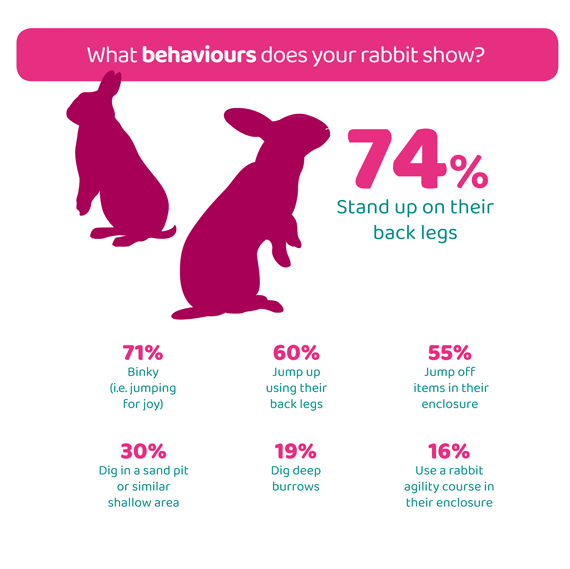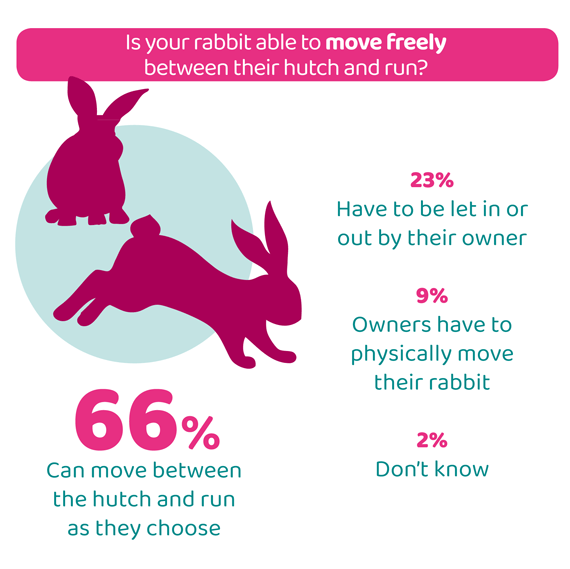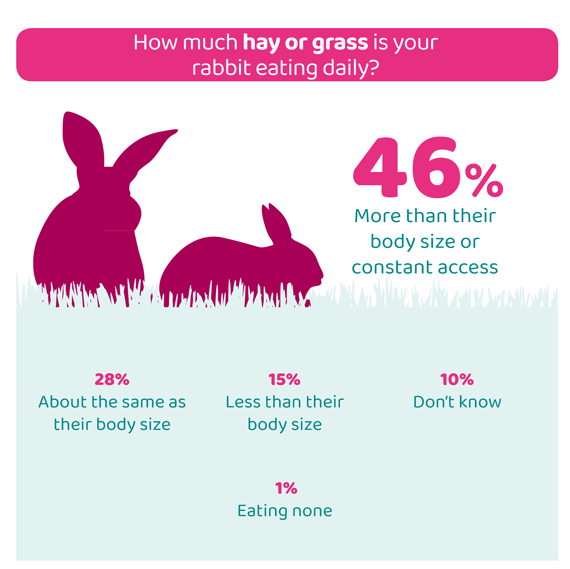Rabbits
Over 14 years of data collection, the PAW Report has consistently found that a large proportion of rabbits are not having their 5 welfare needs met by their owners, and 2024 is sadly no exception. Despite this, rabbit owners tell us they have a higher awareness of the 5 Welfare Needs than the owners of other species. 35% of rabbit owners had heard of the 5 Welfare Needs, compared to 18% of dog and 15% of cat owners.
84% of rabbit owners say that owning a pet improves their life, lower than dog (92%) or cat (91%) owners.



Companionship and behaviour
94% of rabbit owners said they felt informed about their pet’s companionship needs, higher than for both dog (89%) and cat (84%) owners. Companionship is very important for rabbits - studies have shown they are as motivated by the company of other rabbits as much as food32. They need another rabbit to live with for comfort and security, the companionship of a different species is not a suitable substitution due to their different needs and communication33.
In 2024, 42% of rabbits live on their own and 8% live with other species of animals, meaning 50% of rabbits (400,000 rabbits) in the UK are not currently having their companionship needs met. This proportion has remained unchanged since February 2020, although prior to this there had been steady improvement over the years from 2011 when 72% of rabbits lived alone or with other species. It is not clear why the proportion of rabbits living alone has not improved further, but owner awareness of the importance of this welfare need has to play a part. PDSA has worked with other organisations to create the non-statutory Welfare Code for Rabbits to help owners understand their pets’ needs. However, it appears further awareness amongst owners of the importance of this code for their rabbits’ health and welfare is needed – a good way to do this could be if available for owners from wherever they acquire their pet.
In 2021, we found the most common reason for only having one rabbit (34%) was that owners had previously had more than one rabbit, but one had passed away and they chose not to replace them. While we did not ask this question in 2024, we did find some interesting associations that could provide some clues for why owners might choose to keep solitary rabbits. Rabbits who live with other rabbit(s) are more likely to have been acquired from a rescue or rehoming centre (24%) than rabbits who live alone or with other species (16%), which could reflect advice given by these sources. We also found that owners of more than one rabbit were more likely to have had advice from a rescue centre before they got their pet (20%) than those whose rabbit lived alone (10%). Many rehoming centres offer rabbit bonding services, giving guidance to owners looking to introduce another rabbit, this support could encourage owners who might otherwise be unsure about how to ensure their rabbit bonds with another34.
‘New’ rabbit owners, who have not owned a rabbit before as an adult, are more likely to keep their rabbit with one or more rabbits (52%) compared to those who have owned rabbits before (40%). It is possible this may reflect previous experience of owning a single rabbit without recognising the welfare concern, or that they have chosen not to replace a previous rabbit who has died, though we cannot determine this from our data.
Before getting their pet, owners of multiple rabbits were also more likely to have looked for advice on the internet (39% of owners with more than one rabbit, compared to 29% of those with one rabbit) or social media (18% of owners with more than one rabbits compared to 9% of those with one rabbit). This highlights the continued importance of the online work done by welfare organisations, to educate owners and improve the welfare of pet rabbits. Websites and social media pages promoting rabbit pairing services are another initiative to discourage owners from keeping a solitary rabbit.
If rabbits are kept on their own, they risk becoming lonely and stressed35. The lack of companionship could potentially lead to a change in the behaviours they show. Rabbits who live with other rabbits were more likely to binky, i.e. jump for joy (77% compared to 65% who don’t live with other rabbits). They were also more likely to dig in a sand pit or similar shallow area (36% compared to 24% of those who don’t live with other rabbits) and use an agility course in their enclosure (21% compared to 12% who don’t live with other rabbits). However, the ability to show these behaviours could also be affected by whether rabbits have the resources and space to perform these behaviours.


Environment
98% of rabbit owners told us they feel informed about their pet's environmental Welfare Needs, which was higher than cat owners (95%) but no different from dog owners. This is the highest it has been since 2012.
Rabbits need the space in their home to perform natural behaviours such as digging, foraging, hiding, running and standing up on their hind limbs. To provide the space for this, the recommended living area for two average sized rabbits is a single enclosed area of at least 3m x 2m by 1m high36. In 2024, almost a quarter of all pet rabbits (22%) which equates to 180,000 rabbits, continue to have inadequate housing, based on owners selecting an image of small hutches with minimal or no run space as the one most closely resembling their pet’s living arrangements.


This proportion has not improved in the last six years of findings, although is an improvement from 2017 when 35% of rabbits were kept in inadequate housing. Owners whose rabbits lived in inadequate housing were more likely to have chosen this housing because they already had this enclosure from a previous rabbit or pet (20% compared to 9% for rabbits in larger enclosures), because they didn’t have enough space at home for a larger enclosure (16% compared to 5% for rabbits in larger enclosures) or because this was the type of enclosure they could afford (11% compared to 2% of owners of rabbits in larger enclosures). Worryingly, 9% of owners said they chose inadequate housing on advice from the shop where they bought the enclosure and 7% said that they chose it because a larger enclosure wasn’t available to buy. Availability of both appropriate housing and correct advice at the point of sale would be a major step to improving rabbit welfare.
Of those owners whose rabbit lived in adequate (i.e. larger) housing, 57% told us they had chosen this to give them the space they need and 9% said they already had one from a previous rabbit or pet. Only 6% said they chose it on advice from the shop where they bought it and 2% said it was the type they could afford.
It is possible that if an owner is aware of their rabbit’s need for companionship, they are also more aware of their need for a suitable environment. Rabbits who live alone or with other species are more likely to live in inadequate housing (31%) compared to those who live with other rabbits (14%). Similarly, rabbits who live with other rabbits are more likely to live in very good housing (32%) compared to those who live alone or with other species (17%).
Ideally, rabbits should have permanent access to all areas of their accommodation to give them control over their environment and allow for a predictable routine, enabling them to perform natural behaviours at the times of day when they are naturally most active, i.e. dawn, dusk and overnight. 66% of owners told us their rabbit can move between the hutch and run as they choose, 23% that they have to be let in or out by their owner and 9% have to be physically moved from one to the other by their owner. Rabbits in inadequate enclosures are less likely to be able to move between the hutch and run as they choose (33%) compared to those in adequate housing (76%).


Diet
97% of rabbit owners feel informed about their pet’s dietary needs. Rabbits require a high level of fibre in their diet in the form of hay or grass to keep their digestive system functioning normally and to allow natural behaviours such as grazing and foraging as well as to avoid weight gain and obesity37. 86% of rabbits are fed grass or hay as one of their main foods. Significantly more rabbits are being fed fresh grass (19%) compared to 2023 (13%) but less than in 2018 (28%). Ideally, rabbits should have constant access to grass or hay, but as a minimum they should be fed the equivalent of at least their body size daily38. 46% of rabbits are eating more than their body size or have constant access, 28% are eating about the same as their body size and 15% are eating less. More rabbits in 2024 are being fed the correct amount of hay or grass (74%), compared to when last asked in 2022 (63%) and all previous years back to 2017 (46%). Correspondingly, less rabbits are being fed too little hay or grass (16%) compared to 2022 (29%) and all previous years back to 2017 (33%).
As well as high levels of good quality hay and/or grass, rabbits’ diet should also include fresh vegetables and herbs alongside commercial pellets39. 57% of rabbits are being fed hay or grass, together with pellets and fresh greens as their main foods. However, 24%, 180,000 rabbits, are fed an inadequate diet option in their top three main foods* and 3%, 21,000 rabbits, are fed none of the recommended food types as their main food.
17% of rabbits are still fed a muesli mix food as one of their main food types. These diets have been implicated in a variety of health problems, including obesity, dental disease and gastrointestinal disease40. The proportion of rabbits fed muesli as one of their main foods has not changed since 2018 but is lower than in 2017 (25%) and earlier.
A common misconception amongst rabbit owners is that their pet’s commercial food, whether pellets or muesli, should make up the majority of food consumed, when in reality, it should be a supplement to the main diet of hay or grass. Of those owners who are feeding rabbit pellets, only 11% have the recommended amount of one tablespoon daily (29% have two tablespoons, which is the recommended amount for rabbits over 3.5kg). 54% have either three or more tablespoons or unlimited access. Similarly, 54% of those rabbits who are fed muesli mix have three or more tablespoons daily, or unlimited access. Feeding excess amounts of pellets or muesli can lead to obesity, as well as reducing the amount of hay or grass rabbits will eat, as they often preferentially choose commercial diets. In addition, if rabbits are fed too much muesli, they are more likely to preferentially choose certain parts of the diet, leading to nutritional imbalances41.



Preventive health
As we have seen in every year of PAW Report data, in 2024, a lower proportion of rabbits receive each of the preventive healthcare options compared to both dogs and cats, though findings have improved over the last 14 years.
61% of UK pet rabbits are neutered (480,000 rabbits). This figure has increased from 2011 when 37% were neutered. The proportion of rabbits who are neutered has fluctuated over the last six years and this year’s figure is no different from the average over that time period. As well as providing health benefits, neutering rabbits allows them to live happily together in pairs or groups without unwanted pregnancies, so is an essential part of helping owners to ensure their rabbit’s companionship needs are met appropriately. 31% of owners whose rabbit was not neutered said it was because their rabbit lives alone. This was higher than for dog (8%) and cat (12%) owners, despite rabbits’ need for companionship. 7% of owners haven’t had their rabbit neutered because they are worried about the anaesthetic - higher than for cat owners (3%) but no different from dog owners.
54% of rabbits have had regular boosters. Similar to the trend seen with neutering, this has increased from 38% who were receiving regular vaccinations in 2011 but fluctuated over the years since 2017. The 2024 figure is not significantly different from the average over the last seven years. Of the owners whose rabbit has not received regular booster vaccinations, 31% said it was because their pet doesn’t come into contact with other animals and 23% that they don’t go outside. The two main diseases vaccinated against in rabbits in the UK, myxomatosis and rabbit (viral) haemorrhagic disease (R(V)HD) can both be spread by biting insects, so these rabbits remain vulnerable.
21% of rabbits are microchipped, this proportion has increased greatly from only 3% in 2011. In 2024, less rabbits are microchipped compared to February 2020 (30%) and 2021 (29%) but is no different from the average over the last seven years.
23% of rabbits are insured, which has increased from 6% in 2011. Financial reasons remain important for rabbit owners who have chosen not to insure their pets – 37% who haven’t insured said this was because it was too expensive. Rabbit owners were more likely to say they haven’t insured because they feel it’s not necessary (19%) compared to dog (9%) and cat owners (14%), and more likely than dog owners to say it’s because they don’t think they’ll get their money’s worth (27% of rabbit owners compared to 21% of dog owners).
73% of rabbits are currently registered with a vet. This proportion is not significantly different from the average of the last seven years but has increased from 56% in 2011.
10% of rabbits are receiving none of the preventive healthcare options**. As with all preventive healthcare options, this is significantly different from dogs (<1%) and cats (1%). Whilst still a high proportion of rabbits, this has decreased from 23% in 2011 but has not changed over the last seven years. Those rabbits who have had one preventive healthcare options, such as neutering, vaccination or being insured, are more likely to have the other healthcare options too.

Cost of living
As we found with cat owners, the proportion of rabbit owners who say the cost of living has affected how they care for their pet is unchanged from 2023 at 24% (190,000 rabbits), including 8% who have swapped to a cheaper brand of pet food, and 3% who have cancelled their pet insurance. 32% of rabbit owners have made cost-saving decisions to continue caring for their pet, with 20% giving up personal luxuries and 16% saving on their weekly shop. 5% have gone without necessities such as missing meals in order to continue caring for their pet.
7% of rabbit owners who have delayed taking their pet to the vet when they were ill told us it was because they were concerned about the cost. 15% of rabbit owners who have not neutered their pet said it was because it was too expensive, higher than dog owners at 10%, but no different from cat owners. 23% of owners who have not vaccinated their rabbit said it was because it was too expensive and 37% of owners who have not insured their rabbit said it was because it’s too expensive (lower than for dog owners at 45% and cat owners at 43%).
Key findings about rabbits from our 2024 PAW Report
 Video found at youtu.be/9tp0ZTjNvmU
Video found at youtu.be/9tp0ZTjNvmU

Footnotes
* homemade rabbit food, guinea pig food, rabbit muesli mix, scraps/ leftovers of human food, other foods, or none of these
** Neutered, primary vaccinations (when young), regular booster vaccinations, treated for fleas, wormed, currently registered with a vet, insured, microchipped
32 Seaman SC, Waran NK, Mason G, D’Eath RB (2008) Animal economics: assessing the motivation of female laboratory rabbits to reach a platform, social contact and food. Anim Behav 75:31–42
33 Mullan, S., & Saunders, R. (2018). European rabbits (Oryctolagus cuniculus). Companion Animal Care and Welfare: The UFAW Companion Animal Handbook, 163-184.
34 https://woodgreen.org.uk/about-us/woodgreens-small-pet-mixing-service/
35 Burn, C. C., & Shields, P. (2020). Do rabbits need each other? Effects of single versus paired housing on rabbit body temperature and behaviour in a UK shelter. Animal Welfare, 29(2), 209-219
36 Rooney, N. J., Baker, P. E., Blackwell, E. J., Walker, M. G., Mullan, S., Saunders, R. A., & Held, S. D. (2023). Run access, hutch size and time-of-day affect welfare-relevant behaviour and faecal corticosterone in pair-housed pet rabbits. Applied Animal Behaviour Science, 262, 105919.
37 Carabaño, R., Piquer, J., Menoyo, D., & Badiola, I. (2020). The digestive system of the rabbit. Nutrition of the rabbit, (Ed. 3), 1-20.
38 Bourne, D. (2018). Hay for a healthy rabbit: the importance of appropriate feed. Companion Animal, 23(6), 348-352.
39 Meredith, A., & Lord, B. (2014). BSAVA Manual of Rabbit Medicine Nutrition and feeding. Wiley
40 Kazimierska, K., & Biel, W. (2021). Analysis of the nutrient composition of selected commercial pet rabbit feeds with respect to nutritional guidelines. Journal of Exotic Pet Medicine, 39, 32-36
41 Adji, A. V., Pedersen, A. Ø., & Agyekum, A. K. (2022). Obesity in pet rabbits (Oryctolagus cuniculus): A narrative review. Journal of Exotic Pet Medicine, 41, 30-37.






